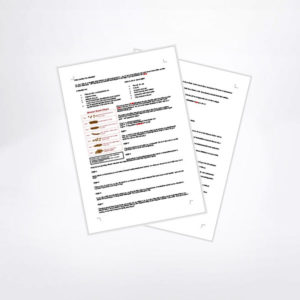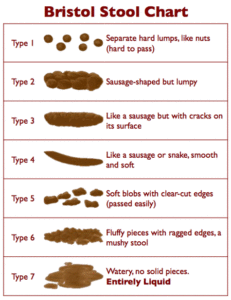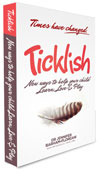 Have you ever wondered how often you should poo, or if your poo was healthy?
Have you ever wondered how often you should poo, or if your poo was healthy?
Okay, after we get passed the awkwardness of this topic most of us would admit we are a little intrigued…
How often we use our bowels and what our poo looks like tells us a lot about our general health and wellbeing.
Without realizing it many of us put ‘Clag-like’ or ‘Glue-like’ products into our bodies 3-5 times a day. Let’s look at a typical “bum glue” day – white bread or cereal for breakfast, cakes and biscuits for morning and afternoon tea and pasta or rice for dinner.
Don’t be disillusioned now into thinking that multi-grain breads, which have grains and seeds added to the ‘white glue substance’ is really that much better for us. Because white flour irrespective of seeds is still glue.
We race around and forget to eat fruit and vegetables, drink enough water or exercise, and then we may wonder why we have bloated tummies and only poo once every few days.
Unfortunately, if we don’t tune in to our bowel health and teach our children to do the same – then over a period of time our whole body including our brain function starts to be affected.
7 Reasons We May Become Constipated
We can’t poo when:
- We haven’t drunk enough water
- We haven’t eaten enough fibre or bulk (fruits and vegetables)
- Our spine is not aligned (vertebral subluxations affects nerve messages between the brain and bowel) chiropractic assists the nervous system re-create body order
- Our foods are not well combined
- We haven’t exercised enough
- We are emotionally tense
- We keep ourselves too busy (we rush them from one activity to another)
Good bowel health gives us energy and vitality and allows us to fight off infections and illness. Healthy bowels create healthy bodies.
Clearly we are not just talking about bathroom habits – we are appreciating that a lack of health affects so many aspects of our lives. When our bowels work well they extract the vitamins and minerals we need to thrive and they remove the toxins we gather from modern living.
What Makes Poo Healthy?
So now that we’ve started to tackle this topic we need to really engage – you are now going to have to look twice at your poo or teach your child to look at their poo —YEP that’s right, you will need to actually look at the shape of your poo and then the colour.
A Healthy Poo:
- Tells us when it is ready to come out
- Slips out easily
- Needs no coaxing
- Is well formed (poo should look like a brown banana with a point at one end or take on an S shape)
- Is well hydrated (poo that looks like little balls wadded together has been in the colon too long)
What Is Not A Good Sign?
- Having no urge
- It hurts
- It takes a long time
- Is always very loose and fast
- Looks like little balls or pieces
- There’s blood or mucus
form scale as a useful guide to intestinal transit time’.
Scandinavian Journal of Gastroenterology,
vol.32, no.9, pp.920 – 924. Retrieved on 2/3/2007.
The type of stool or faeces depends on the time it spends in the colon. After you pass faeces, what you see in the toilet bowl is basically the result of your diet, fluids, medications and lifestyle. You can use the Bristol Stool Chart to check what your stools are telling you.
The Bristol Stool Chart shows seven categories of stool. Every person will have different bowel habits, but the important thing is that your stools are soft and easy to pass – like types 3 and 4 below.
Type 1–2 indicate constipation
Type 3–4 are ideal stools as they are easier to pass, and
Type 5–7 may indicate diarrhoea and urgency.
Type 1
They’ve spent a long time in your bowel and are tough to pass. If your stool looks like this, you’re probably constipated. If it lasts longer than a couple of weeks, see your doctor to find out what’s causing it.
Type 2
This stool also can be a sign that you’re constipated. Try to get more fiber in your diet and drink more water to move things along.
Type 3
Doctors think of this kind of poop as normal, because it’s soft and easy to pass. If things are going as they should, it shouldn’t take longer than a minute on the toilet to push out a poop.
Type 4
Doctors think of this as poop you want to have. Everyone’s bathroom habits are different, but ideally you should have one of these every 1 to 3 days.
Type 5
These are easy to pass, but you may feel a sense of urgency about getting to the bathroom. That can be a sign of mild diarrhea. Most of the time, it goes away on its own in a couple of days.
Type 6
If you have these more than three times a day, you have diarrhea. Make sure to drink plenty of fluids. Water is good, but you also need to replace the minerals you’re losing (called electrolytes). Fruit juices and soup can help.
Type 7
This stool moved through your bowel very quickly. See your doctor if you have more than three of these a day for longer than 2 days. You should check with your doctor if you also have other signs of dehydration (dry mouth, sleepiness, headache, or dizziness), severe pain in your tummy or rear end, or a fever of 102 degrees or higher.
Tips To Foster Bowel Health
1. If you are a parent it is important to make poo habits and digestive health, part of natural family conversation. The easier it is to talk about poo the easier it is too correct poor habits.
2. Two to three good bowel movements a day is considered optimal digestive health; in fact, many children poo after each meal and this completely healthy.
3. Drink plenty of water – on average at least 30ml for every kilogram (or 1ounce for every pound). Here are some examples:
- if your child weighs 40kgs x 30mls they should be drinking at least 1200ml (1.2 litres) of water, or
- an 80kg person x 30mls = 2400mls (2.4 litres)
4. Cut out the CRAP
- too much Coffee dries out the bowel,
- too many Refined sugars breeds bad bacteria,
- avoid Antibiotics wherever possible as they strip away good bacteria
- avoid Processed foods full of man made nasties that compromise digestive health
You could just remember to cut out CRAP, but that would be cheeky!
5. Eat stacks of fruit and vegetables, strive for 10-15 pieces a day. One ‘piece’ is considered roughly the size or length of your hand – such as one apple or one carrot.
6. Remember to chew not just swallow food. Slow down be mindful of what your’e eating. Chewing food and then continued chewing of our food helps kick start the digestive process.
7. Focus on eating foods that ‘look-like’ their original state and how nature intended them. Consume foods that look the same as they did when they were extracted from the ground or the garden. Remember there are no white bread plants!!
8. Eat whole- grain products preferably kamut, spelt and quinoa and gluten free grains as they help flush fat and cholesterol out of your system. Don’t mistake whole-wheat products for whole-grain.
9. Perform some form of sweaty exercise 5 days a week. When we are stagnant our bowels become stagnant.
10. De-stress and slow life down. When we stress we typically are not moving with the flow of life. De-stress and let your life and bowels flow.
11. Check your ‘bowel transit time’. When the digestive system is working well, bowel transit time ranges from 12 to 24 hours.
- To easily test transit time, simply eat a brightly coloured food such as beetroot (at least one or two whole beets), take a mental note of the time it is eaten, and then check each motion to see when a dark red poo emerges.
- Alternative foods you could trial include corn and sesame seeds. Ironically, corn is a grain, not a vegetable, and is extremely hard for the body to digest and assimilate.
As corn passes through the digestive tract mostly undigested, it is a particularly useful food for this transit test.
So while poo may be an awkward topic, it makes sense to check-in with our body and identify how our bowels are coping with our lifestyle stressors.
 When our body is working well then so too are our minds and we are then better able to integrate and connect with the world around us.
When our body is working well then so too are our minds and we are then better able to integrate and connect with the world around us.
For ease we have created a printable PDF summary of the above points that you can put on the fridge.
. . . . .
Warmly,
Jennifer Barham-Floreani
Bach. Chiropractic, Bach. App Clinical Science
Registered internationally, no longer practicing as a chiropractor in Australia.
. . . . .


 Have you ever wondered how often you should poo, or if your poo was healthy?
Have you ever wondered how often you should poo, or if your poo was healthy?


